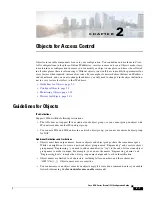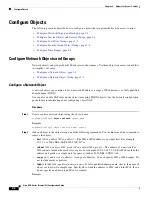
2-7
Cisco ASA Series Firewall CLI Configuration Guide
Chapter 2 Objects for Access Control
Configure Objects
Configure Local User Groups
You can create local user groups for use in features that support the identity firewall by including the
group in an extended ACL, which in turn can be used in an access rule, for example.
The ASA sends an LDAP query to the Active Directory server for user groups globally defined in the
Active Directory domain controller. The ASA imports these groups for identity-based rules. However,
the ASA might have localized network resources that are not defined globally that require local user
groups with localized security policies. Local user groups can contain nested groups and user groups that
are imported from Active Directory. The ASA consolidates local and Active Directory groups.
A user can belong to local user groups and user groups imported from Active Directory.
Because you can use usernames and user group names directly in an ACL, you need to configure local
user groups only if:
•
You want to create a group of users defined in the LOCAL database.
•
You want to create a group of users or user groups that are not captured in a single user group defined
on the AD server.
For information on how to enable the identity firewall, see
Chapter 5, “Identity Firewall.”
Procedure
Step 1
Create or edit a user object group using the object name.
hostname(config)#
object-group user
group_name
Example
hostname(config)# object-group user admins
Step 2
Add users and groups to the user object group using one or more of the following commands. Use the
no
form of the command to remove an object.
•
user
[
domain_NETBIOS_name\
]
username
—A username. If there is a space in the domain name or
username, you must enclose the domain name and user name in quotation marks. The domain name
can be LOCAL (for users defined in the local database) or an Active Directory (AD) domain name
as specified in the
user
-
identity
domain
domain_NetBIOS_name
aaa
-
server
aaa
_
serve
r_
group
_
tag
command. When adding users defined in an AD domain, the
user
_
name
must
be the Active Directory sAMAccountName, which is unique, instead of the common name (cn),
which might not be unique. If you do not specify a domain name, the default is used, which is either
LOCAL or the one defined on the
user-identity default-domain
command.
•
user-group
[
domain_NETBIOS_name\\
]
username
—A user group. If there is a space in the domain
name or group name, you must enclose the domain name and group name in quotation marks. Note
the double \\ that separates the domain and group names.
•
group-object
object_group_name
—The name of an existing user object group.
Example
hostname(config-user-object-group)#
user EXAMPLE\admin
hostname(config-user-object-group)#
user-group EXAMPLE\\managers
hostname(config-user-object-group)# group-object local-admins
Step 3
(Optional) Add a description.
hostname(config-user-object-group)#
description
string
Содержание ASA 5508-X
Страница 11: ...P A R T 1 Access Control ...
Страница 12: ......
Страница 60: ...4 14 Cisco ASA Series Firewall CLI Configuration Guide Chapter 4 Access Rules History for Access Rules ...
Страница 157: ...P A R T 2 Network Address Translation ...
Страница 158: ......
Страница 204: ...9 46 Cisco ASA Series Firewall CLI Configuration Guide Chapter 9 Network Address Translation NAT History for NAT ...
Страница 232: ...10 28 Cisco ASA Series Firewall CLI Configuration Guide Chapter 10 NAT Examples and Reference DNS and NAT ...
Страница 233: ...P A R T 3 Service Policies and Application Inspection ...
Страница 234: ......
Страница 379: ...P A R T 4 Connection Management and Threat Detection ...
Страница 380: ......
Страница 400: ...16 20 Cisco ASA Series Firewall CLI Configuration Guide Chapter 16 Connection Settings History for Connection Settings ...
Страница 414: ...17 14 Cisco ASA Series Firewall CLI Configuration Guide Chapter 17 Quality of Service History for QoS ...
















































